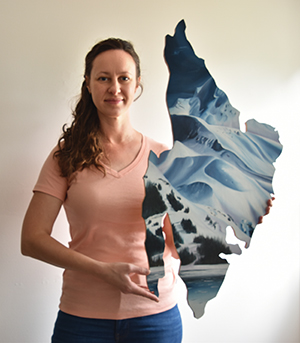An experience in the Peace Corps inspired Lindsey Dunnagan to a career as an artist.
 Lindsey Dunnagan uses her art to explore human interactions with the natural environment. Whether the medium is pencils, paint or Plexiglas, she has always been creative, but it was her life-altering time in the Peace Corps that ultimately pointed her toward a career in art.
Lindsey Dunnagan uses her art to explore human interactions with the natural environment. Whether the medium is pencils, paint or Plexiglas, she has always been creative, but it was her life-altering time in the Peace Corps that ultimately pointed her toward a career in art.
An altruistic nature and a love of new experiences led Dunnagan to her two years of service in Morocco. Armed with an education in business and architecture, she soon realized the local artisans already knew their market and did not really need her assistance in those areas. Dunnagan found other ways to be of service, but she also learned some valuable personal lessons, like how to survive with less personal comfort than she was used to, including going through a snowy winter without heat.
“The people I lived with were more resourceful than anyone I had met before,” she said. “That deeply affected me. Now, when I am in situations that are uncomfortable, I seem to be fine and can usually figure out how to get what I need.”
The toughness she picked up also encouraged Dunnagan to explore a career as an artist. After originally attending Texas A&M University with the intent to become an architect, she changed her plans and decided to utilize her creative talents for her livelihood.
“Living in rural Morocco and learning a new language taught me about grit, and I thought I could handle the insecurities that may come with entering a field that was unfamiliar to me,” she said.
Dunnagan learned she specifically enjoyed working with college students after teaching a watercolor class in graduate school at Texas Women’s University. She came to Truman in 2016 after being offered a tenure-track position and the opportunity to run the Painting Department.
“I really liked the school and the students and faculty that I met when I came to visit. Altogether, it seemed like a great fit,” she said.
As an assistant professor of art, Dunnagan teaches courses in painting, drawing and watercolors, as well as a junior interdisciplinary seminar and capstone classes for BFA and BA students. The last two years have reaffirmed the value of in-person learning.
“The pandemic proved that online learning is not the best fit for all students, educators and fields of study,” Dunnagan said. “When I am with students in painting classes, I can see right away if the reason they can’t get a certain effect is because of the way they are holding their paint brush. That kind of simple technique correction can’t really happen in an online environment. The nuance of learning directly from peers and professors is much more difficult when it comes to hand skills. Many students more quickly advance when studio classes are in person.”
The pandemic also spoiled a return trip to Morocco for Dunnagan. She had planned to take students on a study abroad experience in 2020. While that trip did not work out, she hopes to venture there with students at some point.
With more free time than usual during the pandemic, Dunnagan was able to finally work on a project she has dreamed about since childhood. She wrote and illustrated a children’s book, “The Best Cheese,” about a chef who decides to send cows to the moon to make cheese. It can be found on barnesandnoble.com.
Dunnagan is already working on her second book, and given her creative nature, there is no end to the list of possible projects she may one day pursue. A key component to her success might be her outlook on failure, especially important for anyone working in a creative field and something she tries to relate to students.
“It is ok to fail,” she said. “Failure is a part of life. Failing something gives you information on what needs to change in your life. It does not mean that you are unworthy or that you are not enough. It is so important to remember that even though you may not do well in an area – or many areas – it does not mean you have less value as a person. It is an opportunity to take a step back and reassess.”

